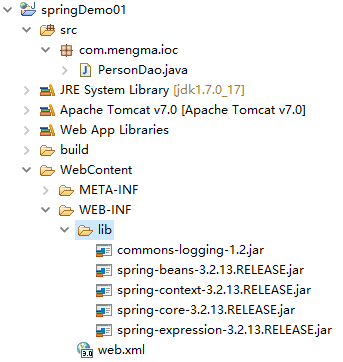第一个Spring程序
通过《Spring IoC容器》的学习,读者对 Spring 的 IoC 容器已经有了一个初步的了解。下面通过具体的案例演示 IoC 容器的使用。

图 1 Spring所需的JAR包
需要注意的是,Spring 的配置文件名称是可以自定义的,通常情况下,都会将配置文件命名为 applicationContext.xml(或 bean.xml)。
从图 2 的输出结果中可以看出,程序已经成功输出了“save()执行了...”语句。在程序执行时,对象的创建并不是通过 new 一个类完成的,而是由 Spring 容器管理实现的。这就是 Spring IoC 容器思想的工作机制。

图 2 输出结果
1. 创建项目
在 MyEclipse 中创建 Web 项目 springDemo01,将 Spring 框架所需的 JAR 包复制到项目的 lib 目录中,并将添加到类路径下,添加后的项目如图 1 所示。
图 1 Spring所需的JAR包
2. 创建 PersonDao 接口
在项目的 src 目录下创建一个名为 com.mengma.ioc 的包,然后在该包中创建一个名为 PersonDao 的接口,并在接口中添加一个 add() 方法,如下所示。
package com.mengma.ioc;
public interface PersonDao {
public void add();
}
3. 创建接口实现类 PersonDaoImpl
在 com.mengma.ioc 包下创建 PersonDao 的实现类 PersonDaoImpl,编辑后如下所示。
package com.mengma.ioc;
public class PersonDaoImpl implements PersonDao {
@Override
public void add() {
System.out.println("save()执行了...");
}
}
上述代码中,PersonDaoImpl 类实现了 PersonDao 接口中的 add() 方法,并且在方法调用时会执行输出语句。
4. 创建 Spring 配置文件
在 src 目录下创建 Spring 的核心配置文件 applicationContext.xml,编辑后如下所示。
<?xml version="1.0" encoding="UTF-8"?>
<beans xmlns="http://www.springframework.org/schema/beans"
xmlns:xsi="http://www.w3.org/2001/XMLSchema-instance" xmlns:p="http://www.springframework.org/schema/p"
xsi:schemaLocation="http://www.springframework.org/schema/beans
http://www.springframework.org/schema/beans/spring-beans-3.2.xsd">
<!-- 由 Spring容器创建该类的实例对象 -->
<bean id="personDao" class="com.mengma.ioc.PersonDaoImpl" />
</beans>
上述代码中,第 2~5 行代码是 Spring 的约束配置,第 7 行代码表示在 Spring 容器中创建一个 id 为 personDao 的 bean 实例,其中 id 表示文件中的唯一标识符,class 属性表示指定需要实例化 Bean 的实全限定类名(包名+类名)。需要注意的是,Spring 的配置文件名称是可以自定义的,通常情况下,都会将配置文件命名为 applicationContext.xml(或 bean.xml)。
5. 编写测试类
在 com.mengma.ioc 包下创建测试类 FirstTest,并在该类中添加一个名为 test1() 的方法,编辑后如下所示。
package com.mengma.ioc;
import org.junit.Test;
import org.springframework.context.ApplicationContext;
import org.springframework.context.support.ClassPathXmlApplicationContext;
public class FirstTest {
@Test
public void testl() {
// 定义Spring配置文件的路径
String xmlPath = "applicationContext.xml";
// 初始化Spring容器,加载配置文件
ApplicationContext applicationContext = new ClassPathXmlApplicationContext(
xmlPath);
// 通过容器获取personDao实例
PersonDao personDao = (PersonDao) applicationContext
.getBean("personDao");
// 调用 personDao 的 add ()方法
personDao.add();
}
}
上述代码中,首先定义了 Spring 配置文件的路径,然后创建 Spring 容器,接下来通过 Spring 容器获取了 personDao 实例,最后调用实例的 save() 方法。6. 运行项目并查看结果
使用 JUnit 测试运行 test1() 方法,运行成功后,控制台的输出结果如图 2 所示。从图 2 的输出结果中可以看出,程序已经成功输出了“save()执行了...”语句。在程序执行时,对象的创建并不是通过 new 一个类完成的,而是由 Spring 容器管理实现的。这就是 Spring IoC 容器思想的工作机制。

图 2 输出结果
所有教程
- socket
- Python基础教程
- C#教程
- MySQL函数
- MySQL
- C语言入门
- C语言专题
- C语言编译器
- C语言编程实例
- GCC编译器
- 数据结构
- C语言项目案例
- C++教程
- OpenCV
- Qt教程
- Unity 3D教程
- UE4
- STL
- Redis
- Android教程
- JavaScript
- PHP
- Mybatis
- Spring Cloud
- Maven
- vi命令
- Spring Boot
- Spring MVC
- Hibernate
- Linux
- Linux命令
- Shell脚本
- Java教程
- 设计模式
- Spring
- Servlet
- Struts2
- Java Swing
- JSP教程
- CSS教程
- TensorFlow
- 区块链
- Go语言教程
- Docker
- 编程笔记
- 资源下载
- 关于我们
- 汇编语言
- 大数据
- 云计算
- VIP视频
